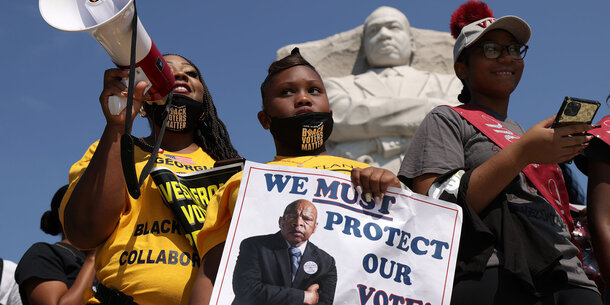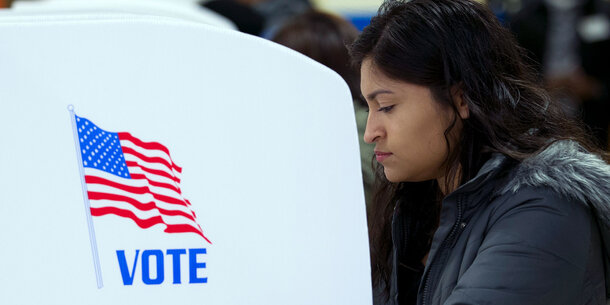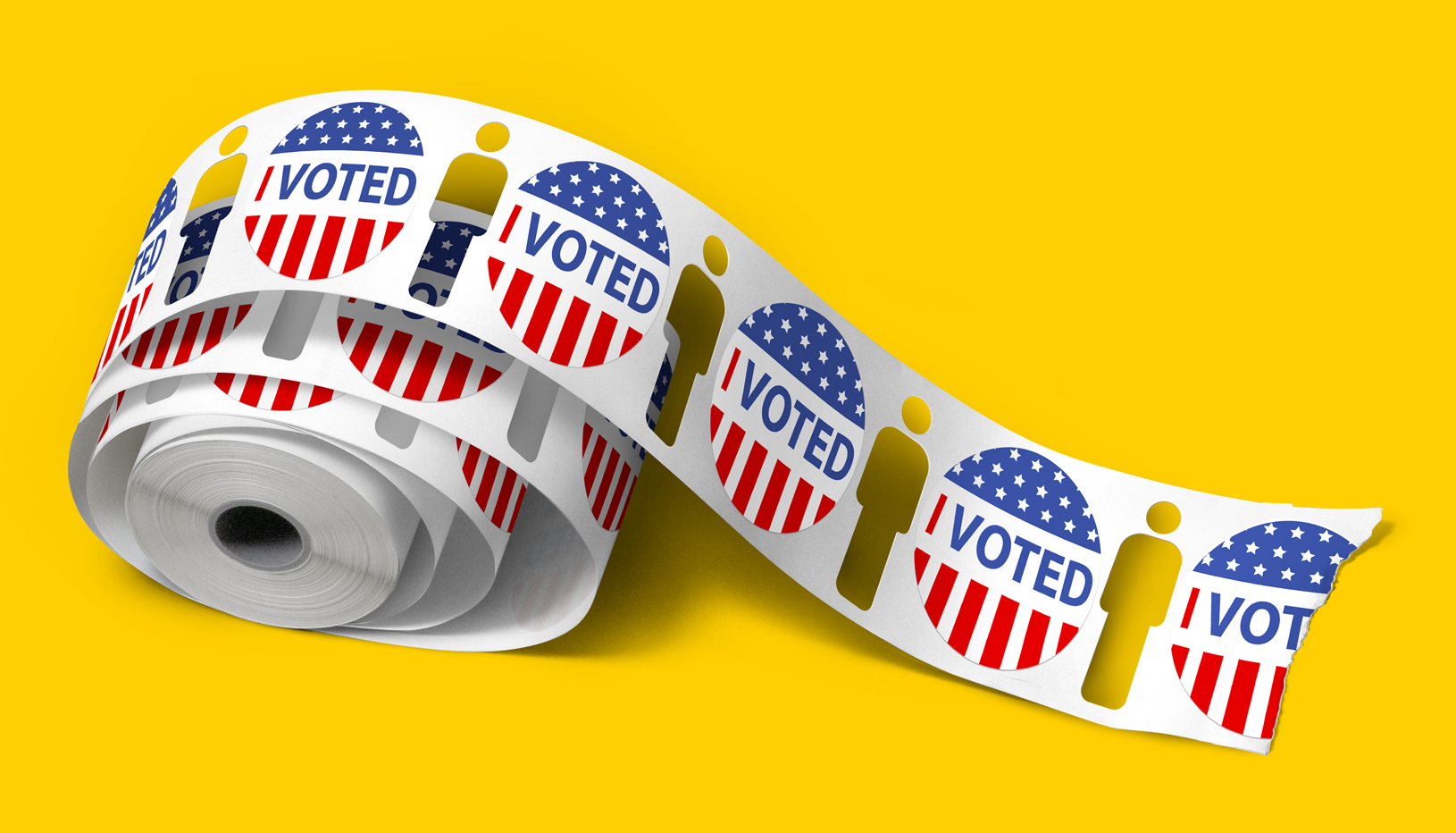Equity for the People
Summary: The For the People Act is a critical step toward achieving an inclusive democracy, long promised, but not yet delivered.

Today, we are at an inflection point. The 2020 election produced the largest number of voters in U.S. history, and the highest turnout in over a century. footnote1_i5fxbw6 1 Domenico Montanaro, “President-Elect Joe Biden Hits 80 Million Votes In Year Of Record Turnout,” NPR, November 25, 2020, https://www.npr.org/2020/11/25/937248659/president-elect-biden-hits-80-million-votes-in-year-of-record-turnout; Kevin Schaul, Kate Rabinowitz, and Ted Mellnik, “2020 Turnout is the Highest in Over a Century,” Washington Post, November 5, 2020, https://www.washingtonpost.com/graphics/2020/elections/voter-turnout/. At the same time, it produced one of the largest-scale attempts to disenfranchise Americans, especially voters of color, in at least half a century. footnote2_6oh6n5p 2 See, e.g., Jacob Shamsian, “Trump’s Lawsuits Are Trying to Throw Out Votes in Counties with More Black People — Even When They Played by the Same Election Rules as Predominantly White Ones,” Business Insider, December 14, 2020, https://www.businessinsider.com/trump-election-lawsuits-target-black-voters-2020–12. On January 6, 2021, insurrectionists violently stormed the United States Capitol, leading to five deaths. This attempted coup was driven by the racially tinged Big Lie of widespread voter fraud, intended to cast doubt on the validity of many votes cast by voters of color in order to falsely allege the presidential election was stolen. While the claim is baseless, it continues to be used as a justification for the introduction of restrictive state-level voting laws in unprecedented numbers — 389 restrictive bills in 48 states as of May 2021 — many of which target voters of color. footnote3_nk667pw 3 Brennan Center for Justice, “Voting Laws Roundup: May 2021,” May 28, 2021, https://www.brennancenter.org/our-work/research-reports/voting-laws-roundup-may-2021; Kevin Morris, “Georgia’s Proposed Voting Restrictions Will Harm Black Voters Most,” Brennan Center for Justice, March 6, 2021, https://www.brennancenter.org/our-work/research-reports/georgias-proposed-voting-restrictions-will-harm-black-voters-most.
That assault on democratic participation comes at a time of dramatic demographic change and social and political transformation. The United States is diversifying and increasingly recognizing diversity as a social good. Americans are more politically engaged than ever, and the newest eligible voters, dubbed Generation Z, are 48 percent nonwhite, making them the most diverse generation the nation has ever seen. footnote4_q3rnt3h 4 Richard Fry and Kim Parker, “Early Benchmarks Show ‘Post-Millennials’ on Track to Be Most Diverse, Best-Educated Generation Yet,” Pew Research Center, November 15, 2018, https://www.pewresearch.org/social-trends/2018/11/15/early-benchmarks-show-post-millennials-on-track-to-be-most-diverse-best-educated-generation-yet/. These young Americans are coming of age in a time where power looks different: for the first time ever, the vice presidency is held by a woman, and a woman of color. For every generation after this, power has a new status quo.
But the attacks on Congress, voting rights, and the 2020 election are a reminder that while the future is coming, our history continues to shape our present. Even while Vice President Kamala Harris represents the possibility of a more inclusive American leadership, she was born into an America where, in many places, she could not vote. The Voting Rights Act, which finally guaranteed the right to vote to people of color, did not become law until 1965, the year after she was born. One-third of Americans alive today were alive during Jim Crow. footnote5_qi15s84 5 Philip Bump, “Nearly a Third of Americans Were Alive During Jim Crow,” Washington Post, August 19, 2019, https://www.washingtonpost.com/politics/2019/08/19/nearly-third-americans-were-alive-during-jim-crow/. Under Jim Crow, whiteness was requisite to power, but it must be noted that although Jim Crow’s power structure definitionally meant all the powerful people were white, all the white people weren’t powerful. For a fascinating analysis of the shared economic struggles of middle-and-working-class Americans across racial lines and how those experiences informed (or failed to inform) the strategy of the civil rights movement, see Risa Goluboff, The Lost Promise of Civil Rights (Cambridge, MA: Harvard University Press, 2007).
The United States’ history of exclusion shapes many of the challenges we face today. Covid-19 has revealed significant racial and ethnic disparities in who is most vulnerable to both the health and economic effects of the pandemic. footnote6_3j4lwbw 6 Compared to white, non-Hispanic people, the CDC reports that, as of May 2021, American Indian or Alaska Native people are hospitalized for Covid-19 at rates that are 3.3 times higher, Black or African Americans at 2.9 times higher, and Hispanic or Latino people at 2.8 times higher. Asian Americans are hospitalized for Covid-19 at approximately the same rate as white Americans. “Risk for COVID-19 Infection, Hospitalization, and Death By Race/Ethnicity,” Centers for Disease Control and Prevention, last modified May 26, 2021, accessed June 3, 2021, https://www.cdc.gov/coronavirus/2019-ncov/covid-data/investigations-discovery/hospitalization-death-by-race-ethnicity.html. And according to a survey conducted by NPR, the Robert Wood Johnson Foundation, and the Harvard T.H. Chan School of Public Health, 72 percent of Latino, 60 percent of Black, and 55 percent of Native American households report facing serious financial problems during the Covid-19 outbreak, compared to just 36 percent of white households. Kelly Anne Smith, “Covid and Race: Households of Color Suffer Most From Pandemic’s Financial Consequences Despite Trillions in Aid,” Forbes, last modified September 17, 2020, https://www.forbes.com/advisor/personal-finance/covid-and-race-households-of-color-suffer-biggest-pandemic-consequences/. Growing gaps between the haves and have-nots track along race and gender lines, with a persistent gender wage gap and vast wealth disparities. footnote7_zbeaxpm 7 Greg Rosalsky, “How the Pandemic is Making the Gender Pay Gap Worse,” NPR, August 18, 2020, https://www.npr.org/sections/money/2020/08/18/903221371/how-the-pandemic-is-making-the-gender-pay-gap-worse; Neil Bhutta et al., “Disparities in Wealth by Race and Ethnicity in the 2019 Survey of Consumer Finances,” FEDS Notes, Board of Governors of the Federal Reserve System, September 28, 2020, https://www.federalreserve.gov/econres/notes/feds-notes/disparities-in-wealth-by-race-and-ethnicity-in-the-2019-survey-of-consumer-finances-20200928.htm. As of 2019, the average net worth of a Black family was about one-eighth that of a typical white family. footnote8_1t3kt7r 8 Bhutta et al., “Disparities in Wealth by Race and Ethnicity.” And Congress does not remotely resemble the nation it governs. The 117th Congress is the most diverse in U.S. history. And yet, it is 77 percent white and 73 percent male. footnote9_zur6w96 9 Katherine Schaeffer, “Racial, Ethnic Diversity Increases Yet Again with the 117th Congress,” Pew Research Center, January 28, 2021, https://www.pewresearch.org/fact-tank/2021/01/28/racial-ethnic-diversity-increases-yet-again-with-the-117th-congress/; Center for American Women and Politics, “CAWP Election Watch: Election 2020 Results Tracker,” Eagleton Institute of Politics, Rutgers University, last modified February 8, 2021, accessed June 3, 2021, https://cawp.rutgers.edu/election2020-results-tracker. By comparison, the nation is roughly 60 percent white and 49 percent male. U.S. Census Bureau, “QuickFacts: United States,” accessed June 3, 2021, https://www.census.gov/quickfacts/fact/table/US/PST0452198. During the 116th Congress, which held the previous record for member diversity, fewer than five percent of U.S. House members cited blue-collar jobs in their biographies, and 70 percent of all members came from just three white collar professions: law, medicine, and business. footnote10_jw79f0g 10 Kristen Bialik, “For the Fifth Time in a Row, the New Congress is the Most Racially and Ethnically Diverse Ever,” Pew Research Center, February 8, 2019, https://www.pewresearch.org/fact-tank/2019/02/08/for-the-fifth-time-in-a-row-the-new-congress-is-the-most-racially-and-ethnically-diverse-ever/; Sahil Chinoy and Jessia Ma, “How Every Member Got to Congress,” New York Times, January 26, 2019, https://www.nytimes.com/interactive/2019/01/26/opinion/sunday/paths-to-congress.html.
The lesson is that governance “by and for the people” has always been an American ideal. And it has always been an unmet ideal: America’s leaders — and the people who choose them with their votes and their dollars — have never fully reflected everyday Americans. This asymmetry between ordinary citizens and the political and donor class in government shapes what policies get made, and whose concerns get prioritized by those in power. Indeed, it shapes who gets to participate, both as voters and leaders, in our democracy. And with a status quo that leaves aside many voters and limits who may lead us, we are constrained in our ability to realize our vision of a government of, by, and for the people. Something must change.
Part of the problem are the rules that structure political power.
Over the past decade, the challenges to a fair and equal democracy have ballooned — from widespread, blatant voter suppression, to extreme and discriminatory gerrymandering, to a campaign finance system increasingly dominated by a small and unrepresentative group of mega donors that serves as a barrier for many diverse candidates running for office. Right now, entrenched interests struggling against a changing demography are making their final, grasping efforts to maintain an exclusionary system. Unfortunately, our laws and institutions are not currently sufficient to prevent this anti-democratic wave and to guarantee a fair and truly representative democracy.
But there is hope. There is a bill for this transformative moment: the For the People Act — our next great civil rights bill. footnote11_2712wir 11 Elizabeth Hira, “The For the People Act is America’s Next Great Civil Rights Bill,” Brennan Center for Justice, March 1, 2021, https://www.brennancenter.org/our-work/analysis-opinion/people-act-americas-next-great-civil-rights-bill. This sweeping package of democracy reforms arrives against the backdrop of an existential crisis over who America is and what we stand for. The reforms of the For the People Act are tailored to meet these exact crises. The bill goes a significant way toward advancing equity in our political systems, all while dismantling many longstanding inequities that have hindered access and narrowed possible outcomes for a democracy that serves everyone. Its most important reforms would combat overt discrimination, affirmatively expand opportunities to vote for all eligible Americans, outlaw discriminatory gerrymandering, and blunt the political effects of wealth inequality.
Ultimately, the For the People Act envisions an inclusive American future where every voter’s voice is heard, and where our leaders represent and reflect our citizens. It is the best opportunity we have ever had to fulfill the American promise of expanding who belongs in “We, the People.” Perhaps most importantly, its basic reforms to the broken infrastructure of democracy are an urgent and necessary prerequisite to make way for the work we must do in every other arena — from protecting healthcare to challenging the climate crisis, advancing education to embracing innovation — work that cannot afford to wait.
Equity for the People by The Brennan Center for Justice on Scribd
End Notes
-
footnote1_i5fxbw6
1
Domenico Montanaro, “President-Elect Joe Biden Hits 80 Million Votes In Year Of Record Turnout,” NPR, November 25, 2020, https://www.npr.org/2020/11/25/937248659/president-elect-biden-hits-80-million-votes-in-year-of-record-turnout; Kevin Schaul, Kate Rabinowitz, and Ted Mellnik, “2020 Turnout is the Highest in Over a Century,” Washington Post, November 5, 2020, https://www.washingtonpost.com/graphics/2020/elections/voter-turnout/. -
footnote2_6oh6n5p
2
See, e.g., Jacob Shamsian, “Trump’s Lawsuits Are Trying to Throw Out Votes in Counties with More Black People — Even When They Played by the Same Election Rules as Predominantly White Ones,” Business Insider, December 14, 2020, https://www.businessinsider.com/trump-election-lawsuits-target-black-voters-2020–12. -
footnote3_nk667pw
3
Brennan Center for Justice, “Voting Laws Roundup: May 2021,” May 28, 2021, https://www.brennancenter.org/our-work/research-reports/voting-laws-roundup-may-2021; Kevin Morris, “Georgia’s Proposed Voting Restrictions Will Harm Black Voters Most,” Brennan Center for Justice, March 6, 2021, https://www.brennancenter.org/our-work/research-reports/georgias-proposed-voting-restrictions-will-harm-black-voters-most. -
footnote4_q3rnt3h
4
Richard Fry and Kim Parker, “Early Benchmarks Show ‘Post-Millennials’ on Track to Be Most Diverse, Best-Educated Generation Yet,” Pew Research Center, November 15, 2018, https://www.pewresearch.org/social-trends/2018/11/15/early-benchmarks-show-post-millennials-on-track-to-be-most-diverse-best-educated-generation-yet/. -
footnote5_qi15s84
5
Philip Bump, “Nearly a Third of Americans Were Alive During Jim Crow,” Washington Post, August 19, 2019, https://www.washingtonpost.com/politics/2019/08/19/nearly-third-americans-were-alive-during-jim-crow/. Under Jim Crow, whiteness was requisite to power, but it must be noted that although Jim Crow’s power structure definitionally meant all the powerful people were white, all the white people weren’t powerful. For a fascinating analysis of the shared economic struggles of middle-and-working-class Americans across racial lines and how those experiences informed (or failed to inform) the strategy of the civil rights movement, see Risa Goluboff, The Lost Promise of Civil Rights (Cambridge, MA: Harvard University Press, 2007). -
footnote6_3j4lwbw
6
Compared to white, non-Hispanic people, the CDC reports that, as of May 2021, American Indian or Alaska Native people are hospitalized for Covid-19 at rates that are 3.3 times higher, Black or African Americans at 2.9 times higher, and Hispanic or Latino people at 2.8 times higher. Asian Americans are hospitalized for Covid-19 at approximately the same rate as white Americans. “Risk for COVID-19 Infection, Hospitalization, and Death By Race/Ethnicity,” Centers for Disease Control and Prevention, last modified May 26, 2021, accessed June 3, 2021, https://www.cdc.gov/coronavirus/2019-ncov/covid-data/investigations-discovery/hospitalization-death-by-race-ethnicity.html. And according to a survey conducted by NPR, the Robert Wood Johnson Foundation, and the Harvard T.H. Chan School of Public Health, 72 percent of Latino, 60 percent of Black, and 55 percent of Native American households report facing serious financial problems during the Covid-19 outbreak, compared to just 36 percent of white households. Kelly Anne Smith, “Covid and Race: Households of Color Suffer Most From Pandemic’s Financial Consequences Despite Trillions in Aid,” Forbes, last modified September 17, 2020, https://www.forbes.com/advisor/personal-finance/covid-and-race-households-of-color-suffer-biggest-pandemic-consequences/. -
footnote7_zbeaxpm
7
Greg Rosalsky, “How the Pandemic is Making the Gender Pay Gap Worse,” NPR, August 18, 2020, https://www.npr.org/sections/money/2020/08/18/903221371/how-the-pandemic-is-making-the-gender-pay-gap-worse; Neil Bhutta et al., “Disparities in Wealth by Race and Ethnicity in the 2019 Survey of Consumer Finances,” FEDS Notes, Board of Governors of the Federal Reserve System, September 28, 2020, https://www.federalreserve.gov/econres/notes/feds-notes/disparities-in-wealth-by-race-and-ethnicity-in-the-2019-survey-of-consumer-finances-20200928.htm. -
footnote8_1t3kt7r
8
Bhutta et al., “Disparities in Wealth by Race and Ethnicity.” -
footnote9_zur6w96
9
Katherine Schaeffer, “Racial, Ethnic Diversity Increases Yet Again with the 117th Congress,” Pew Research Center, January 28, 2021, https://www.pewresearch.org/fact-tank/2021/01/28/racial-ethnic-diversity-increases-yet-again-with-the-117th-congress/; Center for American Women and Politics, “CAWP Election Watch: Election 2020 Results Tracker,” Eagleton Institute of Politics, Rutgers University, last modified February 8, 2021, accessed June 3, 2021, https://cawp.rutgers.edu/election2020-results-tracker. By comparison, the nation is roughly 60 percent white and 49 percent male. U.S. Census Bureau, “QuickFacts: United States,” accessed June 3, 2021, https://www.census.gov/quickfacts/fact/table/US/PST0452198. -
footnote10_jw79f0g
10
Kristen Bialik, “For the Fifth Time in a Row, the New Congress is the Most Racially and Ethnically Diverse Ever,” Pew Research Center, February 8, 2019, https://www.pewresearch.org/fact-tank/2019/02/08/for-the-fifth-time-in-a-row-the-new-congress-is-the-most-racially-and-ethnically-diverse-ever/; Sahil Chinoy and Jessia Ma, “How Every Member Got to Congress,” New York Times, January 26, 2019, https://www.nytimes.com/interactive/2019/01/26/opinion/sunday/paths-to-congress.html. -
footnote11_2712wir
11
Elizabeth Hira, “The For the People Act is America’s Next Great Civil Rights Bill,” Brennan Center for Justice, March 1, 2021, https://www.brennancenter.org/our-work/analysis-opinion/people-act-americas-next-great-civil-rights-bill.









